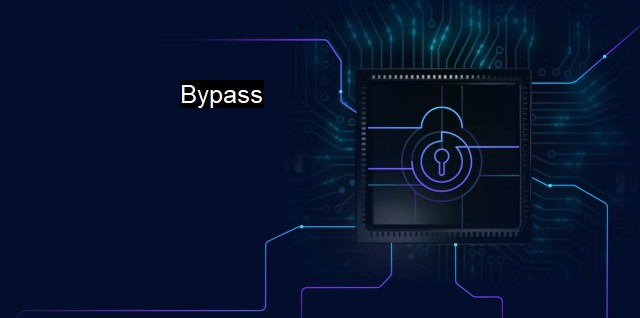What are Bypass?
Bypassing: A Look into the Various Techniques Used by Hackers to Evade Cybersecurity and Antivirus Software
"Bypass" in cybersecurity and antivirus is essentially an evasion technique attackers use to get past or 'bypass' cryptographic system controls, notably security mechanisms and protocols, implemented to maintain secure boundaries and protect data. With this lucrative strategy, adversaries can break a system's security guidelines without the immediate knowledge of users or administrators.Often, the individuals trying to bypass systems are cybercriminals scheming the installation of malicious software or malware, like viruses, spyware, and ransomware. These advanced cyber-threats then compromise the afflicted organization's sensitive material, causing reputational harm, financial losses, to name just a few.
In this context, bypass refers not only to evading actual security safeguards but also camouflaging harmful operations to resemble legitimate system activities. Many active viruses use these advanced stealth strategies to thwart traditional antivirus programs, exploiting vulnerabilities in applications or the operating system itself, thereby remaining unseen and unaddressed. As a result, they can easily escape the detection or obstruct the operation of the counteractive mechanisms these systems have established—causing these attacks to pose an even more substantial risk.
A common bypass methodology includes any form of social engineering, which manipulates people into giving away crucial information which enables the attackers to bypass standard cyber defense protocols. Six types of most common social engineering attacks are phishing, pretexting, baiting, quid pro quo, tailgating and diversion theft.
Various bypass methods can evade anti-virus protection software, exploiting flaws within the antivirus's operational mechanisms. Fileless attacks, for instance, are intricate methods that involve the initiation of malicious activities directly in the computer's memory, bypassing the filesystem where most antivirus solutions showcase their detection work.
Without interacting with the filesystem, the standard antivirus software may fail to identify this cabalistic breach effectively. This specific bypass method has a strong likelihood of omittance by conventional antivirus protocols due to its carefully engineered memory-based execution pattern.
Threat actors tend to utilize packed or encrypted malware versions since many antivirus solutions fail to decode the mal-content hidden within these protective layers. Packed malware is another approach towards bypass that involves compressing or encrypting an executable file, thereby ensuring that malicious activities are hidden and unreachable.
Polymorphic viruses offer another avenue for evasion. These mutating viruses automatically revise their code every time they move to a new device, making the identification and removal of this particular breed of virus a tough challenge for antivirus systems. Therefore, a polymorphic virus effectively bypasses the typical, signature-based scanning operations of such malware-attack interceptors.
It goes without explaining: the advent and perpetuation of bypass tactics have severely destabilized the cybersecurity paradigms of many, be it individuals or organizations struggling with concentrated attacks targeted at manipulating vulnerabilities and gaining unsolicited access. Just as we update our devices and applications regularly, it stands to reason that contemporary cybersecurity mechanisms, too, necessitate revisits and overhauls.
Security bypasses —thanks to unprecedented levels of innovation— now represent rapidly evolving, critical threats to the digital world's stability and security. Consequently, standards for cybersecurity must be progressive, with adequate focus upon making defenses as dynamic, agile, and as resilient as possible. It would involve keeping close tabs on the antagonists' methodologies, along with constant revisits, updates, and revisions, to ensure an integral cyber environment and keep the valuable data secured. Notably, a heavy accent upon user education and employing advanced, real-time threat detection systems that go beyond mere signature-based detection can go a long way in thwarting bypass methods that reroute cybersecurity defenses.
Thus, overly simplified strategies in an ever-complex universe of cyber threats can no longer afford us the desired peace-of-mind. As the concept and methodology of bypass persist, codified within the predatory landscape of cybersecurity, organizations must deviate from traditional understandings of security toward more innovative, multifaceted approaches of managing potential threats, maintaining data integrity and preserving-and hopefully elevating-cybersecurity norms in the process. Nothing short of this would suffice before a lurking bypass threat in our digital age.

Bypass FAQs
What is bypass in cybersecurity?
In cybersecurity, bypass refers to finding a way to evade or overcome security measures such as firewalls or antivirus software. This can be done to gain unauthorized access to networks or data.How can bypass affect my computer's security?
Bypassing security measures can leave your computer vulnerable to malware, ransomware, or other types of cyberattacks. It can also compromise your personal data and sensitive information stored on your device.What are some common bypassing techniques used by hackers?
Some common techniques used by hackers to bypass security measures include social engineering, malware injection, and exploiting vulnerabilities in software or hardware. They may also use steganography, which is hiding malicious code in seemingly harmless files or images.How can I prevent bypass attacks on my computer?
To prevent bypass attacks, it is important to keep your antivirus software updated, regularly scan your computer for malware, and avoid clicking on suspicious links or downloading unauthorized software. You can also use a virtual private network (VPN) to encrypt your web traffic and protect your online activity.| | A | | | B | | | C | | | D | | | E | | | F | | | G | | | H | | | I | | | J | | | K | | | L | | | M | |
| | N | | | O | | | P | | | Q | | | R | | | S | | | T | | | U | | | V | | | W | | | X | | | Y | | | Z | |
| | 1 | | | 2 | | | 3 | | | 4 | | | 7 | | | 8 | | |||||||